Comprehensive Stakeholder Analysis Report: Marks and Spencer Retailer
VerifiedAdded on 2023/01/13
|12
|3539
|21
Report
AI Summary
This report provides a comprehensive stakeholder analysis of Marks and Spencer, a multinational British retailer. It begins with an executive summary and introduction, defining stakeholders and outlining the report's scope. The main body delves into the functional areas within a business, specifically focusing on operations, marketing, finance, and customer service within Marks and Spencer. It identifies both internal stakeholders (managers, employees, shareholders) and external stakeholders (suppliers, customers, competitors, government). A detailed stakeholder matrix, specifically a power-interest matrix, is presented to categorize stakeholders based on their influence and interest levels. The report also examines the nature and degree of stakeholders' interests, potential conflicts, and their overall influence on the company. Furthermore, it compares stakeholder dynamics between the retail and manufacturing industries, highlighting dissimilarities and differences in stakeholder interests and influences. The conclusion summarizes the key findings, reinforcing the importance of stakeholder management for Marks and Spencer's success. The report utilizes relevant academic sources to support its analysis.
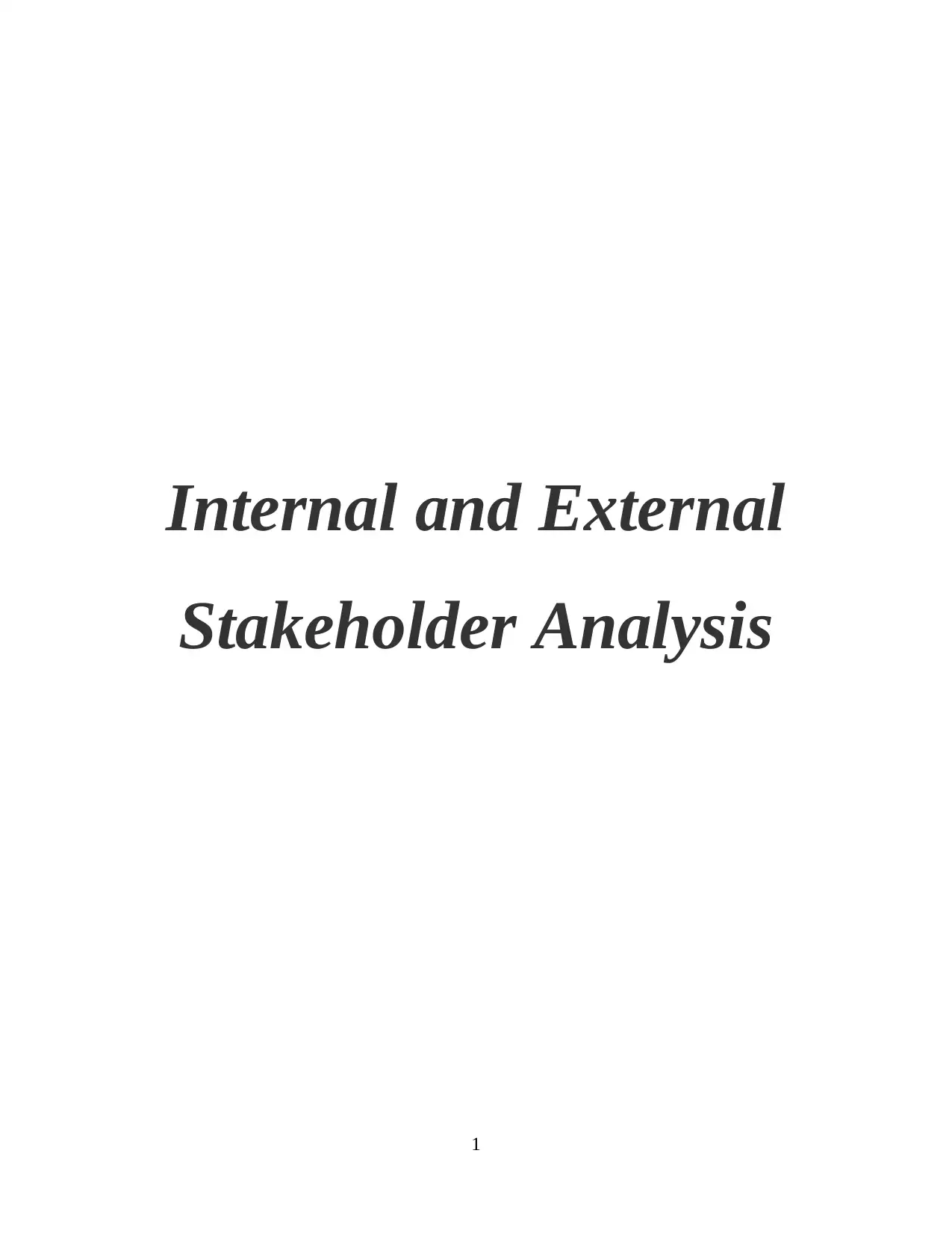
Internal and External
Stakeholder Analysis
1
Stakeholder Analysis
1
Paraphrase This Document
Need a fresh take? Get an instant paraphrase of this document with our AI Paraphraser
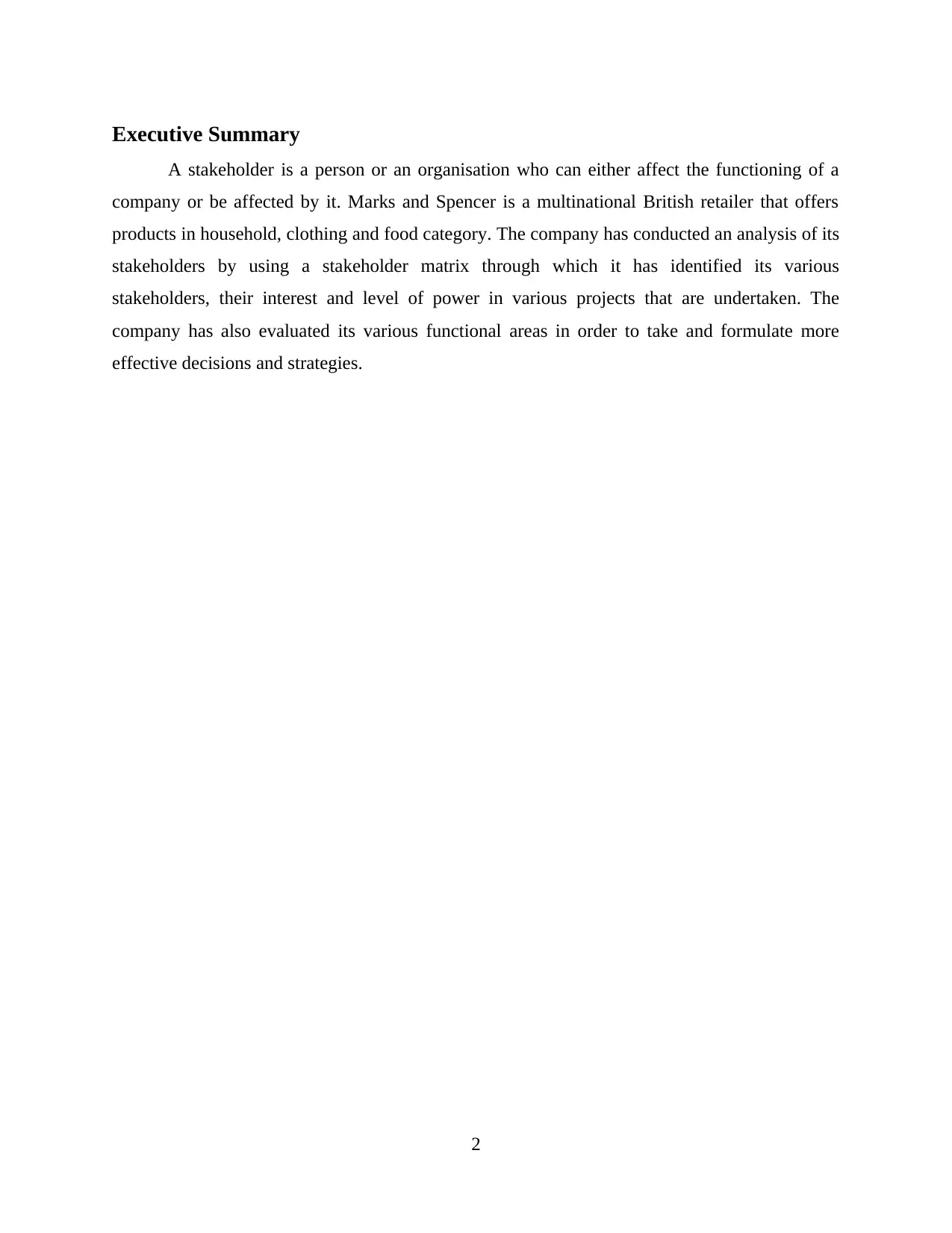
Executive Summary
A stakeholder is a person or an organisation who can either affect the functioning of a
company or be affected by it. Marks and Spencer is a multinational British retailer that offers
products in household, clothing and food category. The company has conducted an analysis of its
stakeholders by using a stakeholder matrix through which it has identified its various
stakeholders, their interest and level of power in various projects that are undertaken. The
company has also evaluated its various functional areas in order to take and formulate more
effective decisions and strategies.
2
A stakeholder is a person or an organisation who can either affect the functioning of a
company or be affected by it. Marks and Spencer is a multinational British retailer that offers
products in household, clothing and food category. The company has conducted an analysis of its
stakeholders by using a stakeholder matrix through which it has identified its various
stakeholders, their interest and level of power in various projects that are undertaken. The
company has also evaluated its various functional areas in order to take and formulate more
effective decisions and strategies.
2
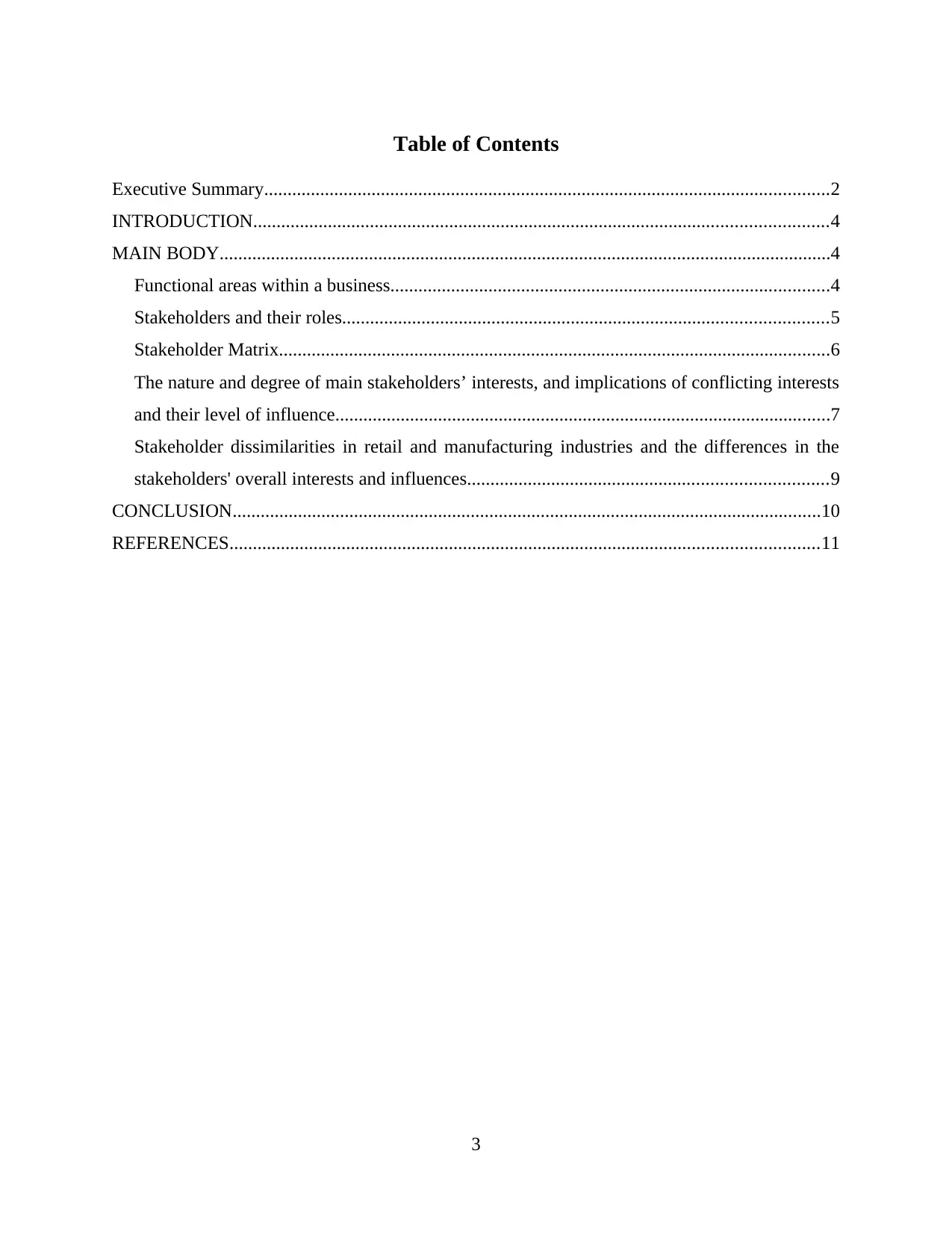
Table of Contents
Executive Summary.........................................................................................................................2
INTRODUCTION...........................................................................................................................4
MAIN BODY...................................................................................................................................4
Functional areas within a business..............................................................................................4
Stakeholders and their roles........................................................................................................5
Stakeholder Matrix......................................................................................................................6
The nature and degree of main stakeholders’ interests, and implications of conflicting interests
and their level of influence..........................................................................................................7
Stakeholder dissimilarities in retail and manufacturing industries and the differences in the
stakeholders' overall interests and influences.............................................................................9
CONCLUSION..............................................................................................................................10
REFERENCES..............................................................................................................................11
3
Executive Summary.........................................................................................................................2
INTRODUCTION...........................................................................................................................4
MAIN BODY...................................................................................................................................4
Functional areas within a business..............................................................................................4
Stakeholders and their roles........................................................................................................5
Stakeholder Matrix......................................................................................................................6
The nature and degree of main stakeholders’ interests, and implications of conflicting interests
and their level of influence..........................................................................................................7
Stakeholder dissimilarities in retail and manufacturing industries and the differences in the
stakeholders' overall interests and influences.............................................................................9
CONCLUSION..............................................................................................................................10
REFERENCES..............................................................................................................................11
3
⊘ This is a preview!⊘
Do you want full access?
Subscribe today to unlock all pages.

Trusted by 1+ million students worldwide
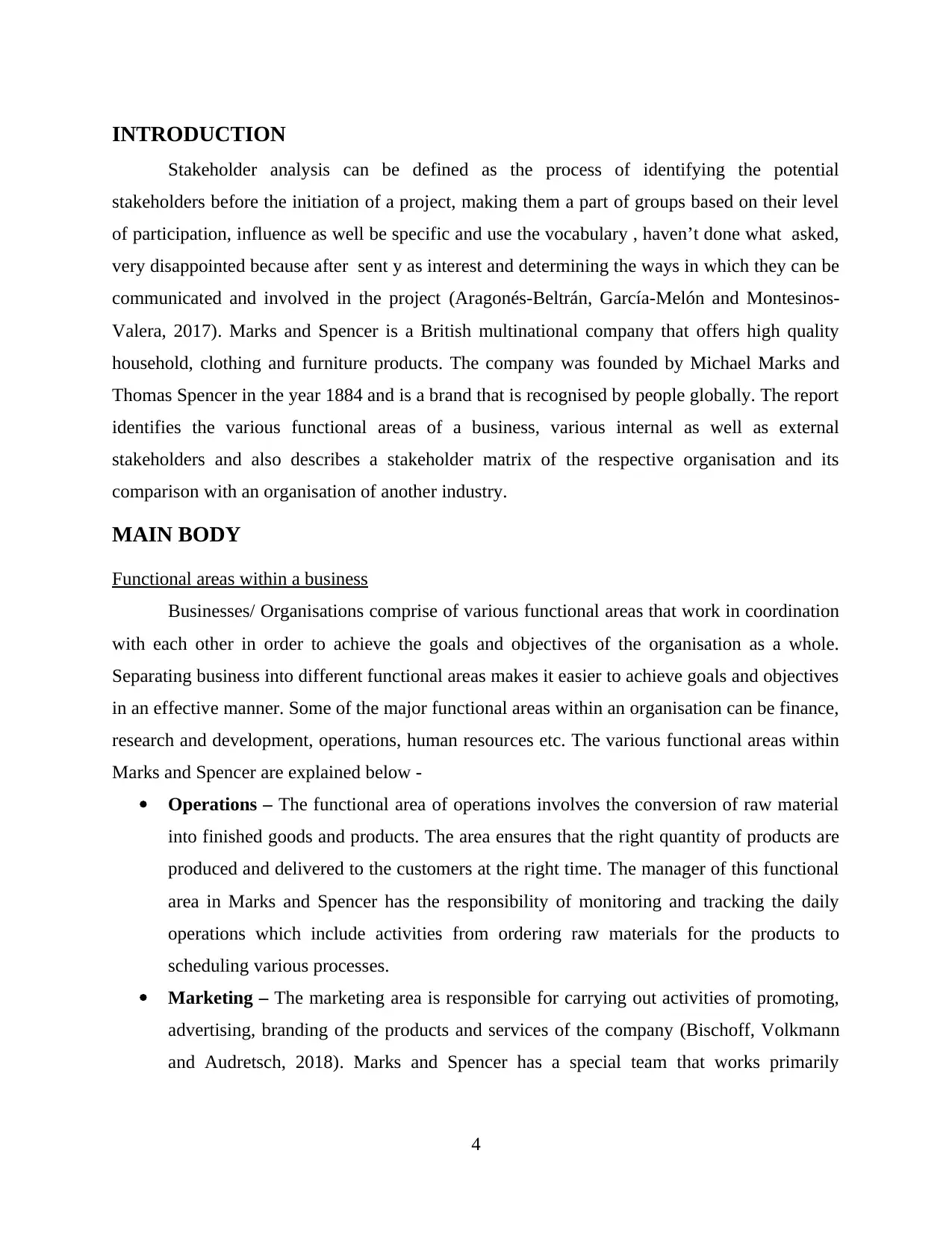
INTRODUCTION
Stakeholder analysis can be defined as the process of identifying the potential
stakeholders before the initiation of a project, making them a part of groups based on their level
of participation, influence as well be specific and use the vocabulary , haven’t done what asked,
very disappointed because after sent y as interest and determining the ways in which they can be
communicated and involved in the project (Aragonés-Beltrán, García-Melón and Montesinos-
Valera, 2017). Marks and Spencer is a British multinational company that offers high quality
household, clothing and furniture products. The company was founded by Michael Marks and
Thomas Spencer in the year 1884 and is a brand that is recognised by people globally. The report
identifies the various functional areas of a business, various internal as well as external
stakeholders and also describes a stakeholder matrix of the respective organisation and its
comparison with an organisation of another industry.
MAIN BODY
Functional areas within a business
Businesses/ Organisations comprise of various functional areas that work in coordination
with each other in order to achieve the goals and objectives of the organisation as a whole.
Separating business into different functional areas makes it easier to achieve goals and objectives
in an effective manner. Some of the major functional areas within an organisation can be finance,
research and development, operations, human resources etc. The various functional areas within
Marks and Spencer are explained below -
Operations – The functional area of operations involves the conversion of raw material
into finished goods and products. The area ensures that the right quantity of products are
produced and delivered to the customers at the right time. The manager of this functional
area in Marks and Spencer has the responsibility of monitoring and tracking the daily
operations which include activities from ordering raw materials for the products to
scheduling various processes.
Marketing – The marketing area is responsible for carrying out activities of promoting,
advertising, branding of the products and services of the company (Bischoff, Volkmann
and Audretsch, 2018). Marks and Spencer has a special team that works primarily
4
Stakeholder analysis can be defined as the process of identifying the potential
stakeholders before the initiation of a project, making them a part of groups based on their level
of participation, influence as well be specific and use the vocabulary , haven’t done what asked,
very disappointed because after sent y as interest and determining the ways in which they can be
communicated and involved in the project (Aragonés-Beltrán, García-Melón and Montesinos-
Valera, 2017). Marks and Spencer is a British multinational company that offers high quality
household, clothing and furniture products. The company was founded by Michael Marks and
Thomas Spencer in the year 1884 and is a brand that is recognised by people globally. The report
identifies the various functional areas of a business, various internal as well as external
stakeholders and also describes a stakeholder matrix of the respective organisation and its
comparison with an organisation of another industry.
MAIN BODY
Functional areas within a business
Businesses/ Organisations comprise of various functional areas that work in coordination
with each other in order to achieve the goals and objectives of the organisation as a whole.
Separating business into different functional areas makes it easier to achieve goals and objectives
in an effective manner. Some of the major functional areas within an organisation can be finance,
research and development, operations, human resources etc. The various functional areas within
Marks and Spencer are explained below -
Operations – The functional area of operations involves the conversion of raw material
into finished goods and products. The area ensures that the right quantity of products are
produced and delivered to the customers at the right time. The manager of this functional
area in Marks and Spencer has the responsibility of monitoring and tracking the daily
operations which include activities from ordering raw materials for the products to
scheduling various processes.
Marketing – The marketing area is responsible for carrying out activities of promoting,
advertising, branding of the products and services of the company (Bischoff, Volkmann
and Audretsch, 2018). Marks and Spencer has a special team that works primarily
4
Paraphrase This Document
Need a fresh take? Get an instant paraphrase of this document with our AI Paraphraser
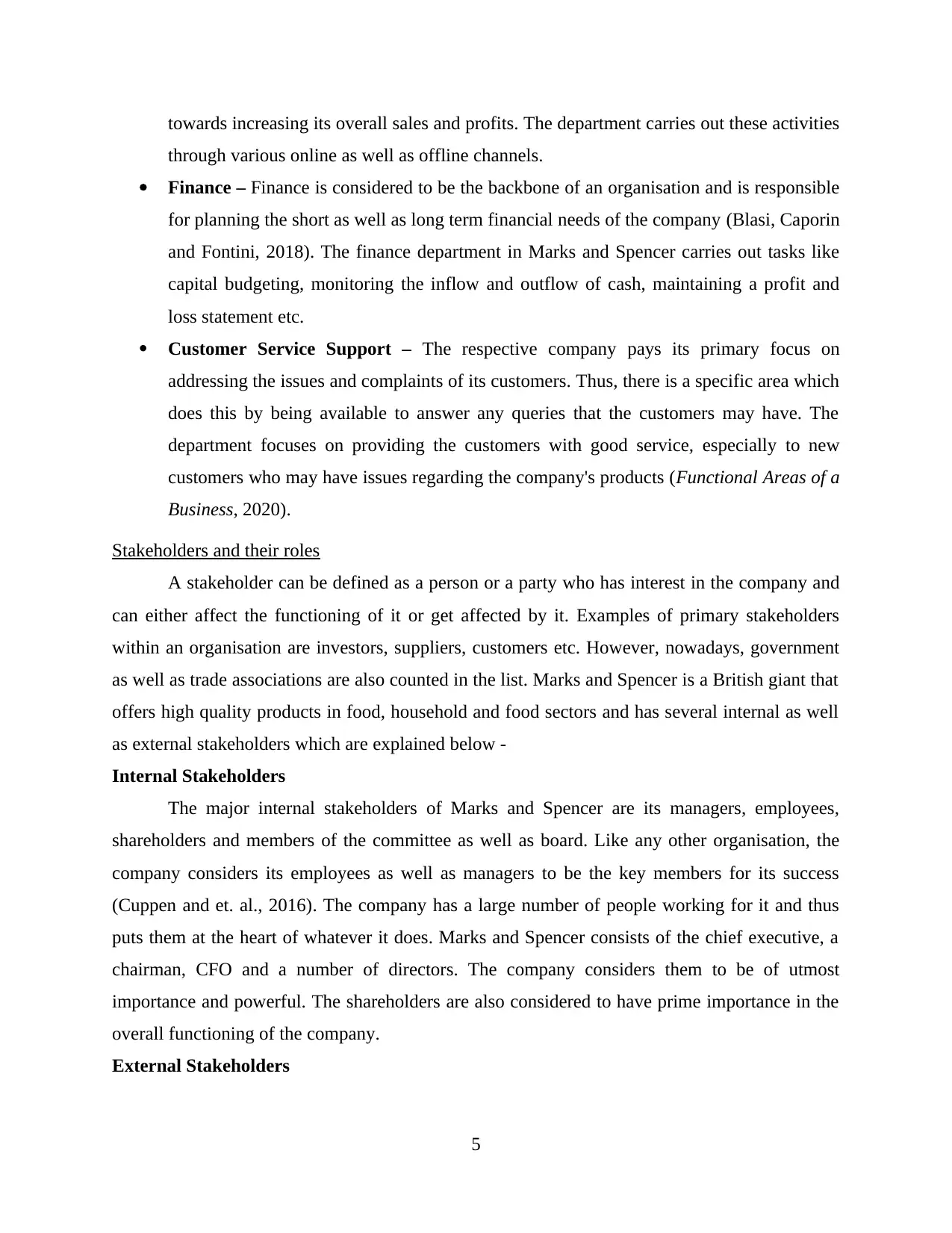
towards increasing its overall sales and profits. The department carries out these activities
through various online as well as offline channels.
Finance – Finance is considered to be the backbone of an organisation and is responsible
for planning the short as well as long term financial needs of the company (Blasi, Caporin
and Fontini, 2018). The finance department in Marks and Spencer carries out tasks like
capital budgeting, monitoring the inflow and outflow of cash, maintaining a profit and
loss statement etc.
Customer Service Support – The respective company pays its primary focus on
addressing the issues and complaints of its customers. Thus, there is a specific area which
does this by being available to answer any queries that the customers may have. The
department focuses on providing the customers with good service, especially to new
customers who may have issues regarding the company's products (Functional Areas of a
Business, 2020).
Stakeholders and their roles
A stakeholder can be defined as a person or a party who has interest in the company and
can either affect the functioning of it or get affected by it. Examples of primary stakeholders
within an organisation are investors, suppliers, customers etc. However, nowadays, government
as well as trade associations are also counted in the list. Marks and Spencer is a British giant that
offers high quality products in food, household and food sectors and has several internal as well
as external stakeholders which are explained below -
Internal Stakeholders
The major internal stakeholders of Marks and Spencer are its managers, employees,
shareholders and members of the committee as well as board. Like any other organisation, the
company considers its employees as well as managers to be the key members for its success
(Cuppen and et. al., 2016). The company has a large number of people working for it and thus
puts them at the heart of whatever it does. Marks and Spencer consists of the chief executive, a
chairman, CFO and a number of directors. The company considers them to be of utmost
importance and powerful. The shareholders are also considered to have prime importance in the
overall functioning of the company.
External Stakeholders
5
through various online as well as offline channels.
Finance – Finance is considered to be the backbone of an organisation and is responsible
for planning the short as well as long term financial needs of the company (Blasi, Caporin
and Fontini, 2018). The finance department in Marks and Spencer carries out tasks like
capital budgeting, monitoring the inflow and outflow of cash, maintaining a profit and
loss statement etc.
Customer Service Support – The respective company pays its primary focus on
addressing the issues and complaints of its customers. Thus, there is a specific area which
does this by being available to answer any queries that the customers may have. The
department focuses on providing the customers with good service, especially to new
customers who may have issues regarding the company's products (Functional Areas of a
Business, 2020).
Stakeholders and their roles
A stakeholder can be defined as a person or a party who has interest in the company and
can either affect the functioning of it or get affected by it. Examples of primary stakeholders
within an organisation are investors, suppliers, customers etc. However, nowadays, government
as well as trade associations are also counted in the list. Marks and Spencer is a British giant that
offers high quality products in food, household and food sectors and has several internal as well
as external stakeholders which are explained below -
Internal Stakeholders
The major internal stakeholders of Marks and Spencer are its managers, employees,
shareholders and members of the committee as well as board. Like any other organisation, the
company considers its employees as well as managers to be the key members for its success
(Cuppen and et. al., 2016). The company has a large number of people working for it and thus
puts them at the heart of whatever it does. Marks and Spencer consists of the chief executive, a
chairman, CFO and a number of directors. The company considers them to be of utmost
importance and powerful. The shareholders are also considered to have prime importance in the
overall functioning of the company.
External Stakeholders
5
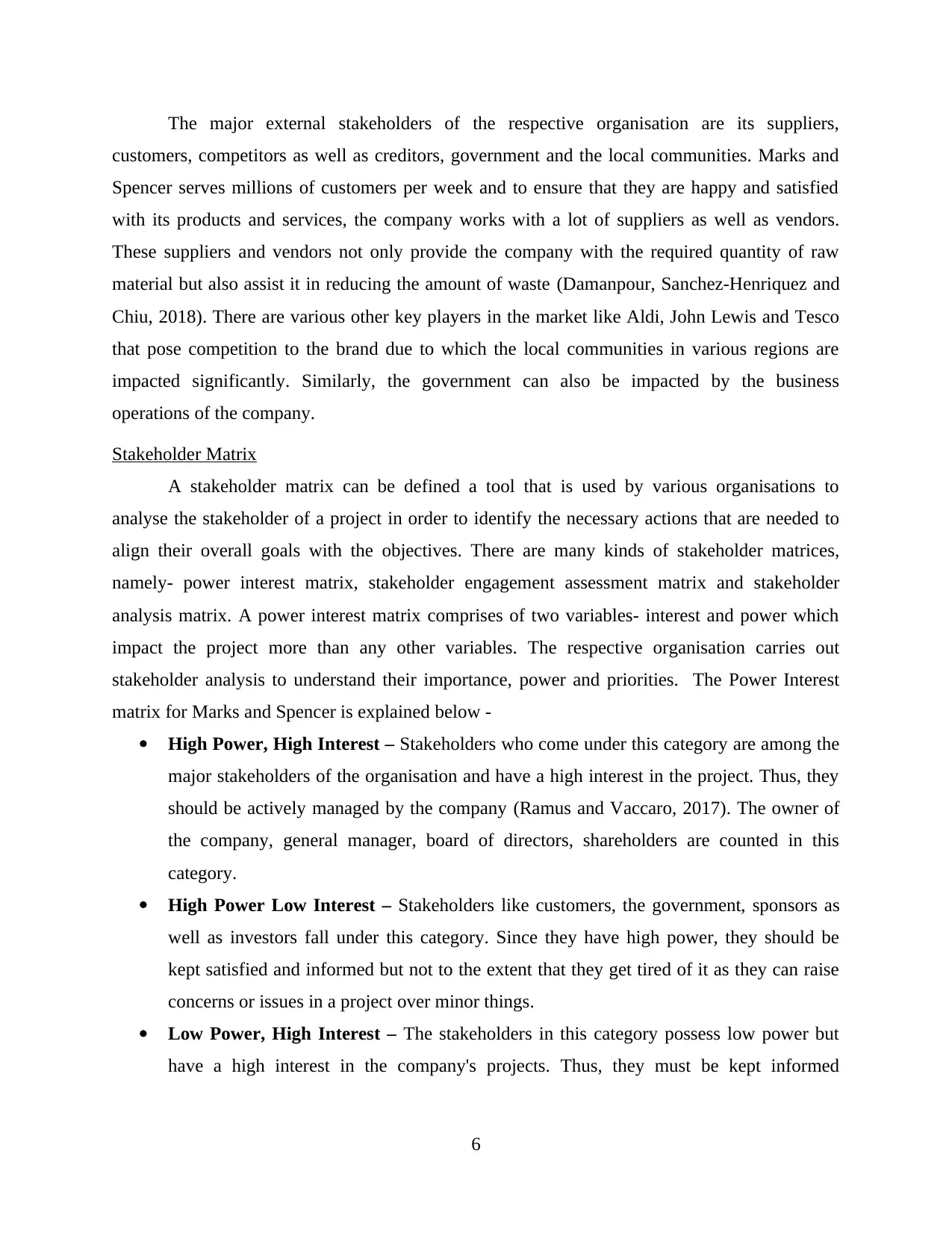
The major external stakeholders of the respective organisation are its suppliers,
customers, competitors as well as creditors, government and the local communities. Marks and
Spencer serves millions of customers per week and to ensure that they are happy and satisfied
with its products and services, the company works with a lot of suppliers as well as vendors.
These suppliers and vendors not only provide the company with the required quantity of raw
material but also assist it in reducing the amount of waste (Damanpour, Sanchez‐Henriquez and
Chiu, 2018). There are various other key players in the market like Aldi, John Lewis and Tesco
that pose competition to the brand due to which the local communities in various regions are
impacted significantly. Similarly, the government can also be impacted by the business
operations of the company.
Stakeholder Matrix
A stakeholder matrix can be defined a tool that is used by various organisations to
analyse the stakeholder of a project in order to identify the necessary actions that are needed to
align their overall goals with the objectives. There are many kinds of stakeholder matrices,
namely- power interest matrix, stakeholder engagement assessment matrix and stakeholder
analysis matrix. A power interest matrix comprises of two variables- interest and power which
impact the project more than any other variables. The respective organisation carries out
stakeholder analysis to understand their importance, power and priorities. The Power Interest
matrix for Marks and Spencer is explained below -
High Power, High Interest – Stakeholders who come under this category are among the
major stakeholders of the organisation and have a high interest in the project. Thus, they
should be actively managed by the company (Ramus and Vaccaro, 2017). The owner of
the company, general manager, board of directors, shareholders are counted in this
category.
High Power Low Interest – Stakeholders like customers, the government, sponsors as
well as investors fall under this category. Since they have high power, they should be
kept satisfied and informed but not to the extent that they get tired of it as they can raise
concerns or issues in a project over minor things.
Low Power, High Interest – The stakeholders in this category possess low power but
have a high interest in the company's projects. Thus, they must be kept informed
6
customers, competitors as well as creditors, government and the local communities. Marks and
Spencer serves millions of customers per week and to ensure that they are happy and satisfied
with its products and services, the company works with a lot of suppliers as well as vendors.
These suppliers and vendors not only provide the company with the required quantity of raw
material but also assist it in reducing the amount of waste (Damanpour, Sanchez‐Henriquez and
Chiu, 2018). There are various other key players in the market like Aldi, John Lewis and Tesco
that pose competition to the brand due to which the local communities in various regions are
impacted significantly. Similarly, the government can also be impacted by the business
operations of the company.
Stakeholder Matrix
A stakeholder matrix can be defined a tool that is used by various organisations to
analyse the stakeholder of a project in order to identify the necessary actions that are needed to
align their overall goals with the objectives. There are many kinds of stakeholder matrices,
namely- power interest matrix, stakeholder engagement assessment matrix and stakeholder
analysis matrix. A power interest matrix comprises of two variables- interest and power which
impact the project more than any other variables. The respective organisation carries out
stakeholder analysis to understand their importance, power and priorities. The Power Interest
matrix for Marks and Spencer is explained below -
High Power, High Interest – Stakeholders who come under this category are among the
major stakeholders of the organisation and have a high interest in the project. Thus, they
should be actively managed by the company (Ramus and Vaccaro, 2017). The owner of
the company, general manager, board of directors, shareholders are counted in this
category.
High Power Low Interest – Stakeholders like customers, the government, sponsors as
well as investors fall under this category. Since they have high power, they should be
kept satisfied and informed but not to the extent that they get tired of it as they can raise
concerns or issues in a project over minor things.
Low Power, High Interest – The stakeholders in this category possess low power but
have a high interest in the company's projects. Thus, they must be kept informed
6
⊘ This is a preview!⊘
Do you want full access?
Subscribe today to unlock all pages.

Trusted by 1+ million students worldwide
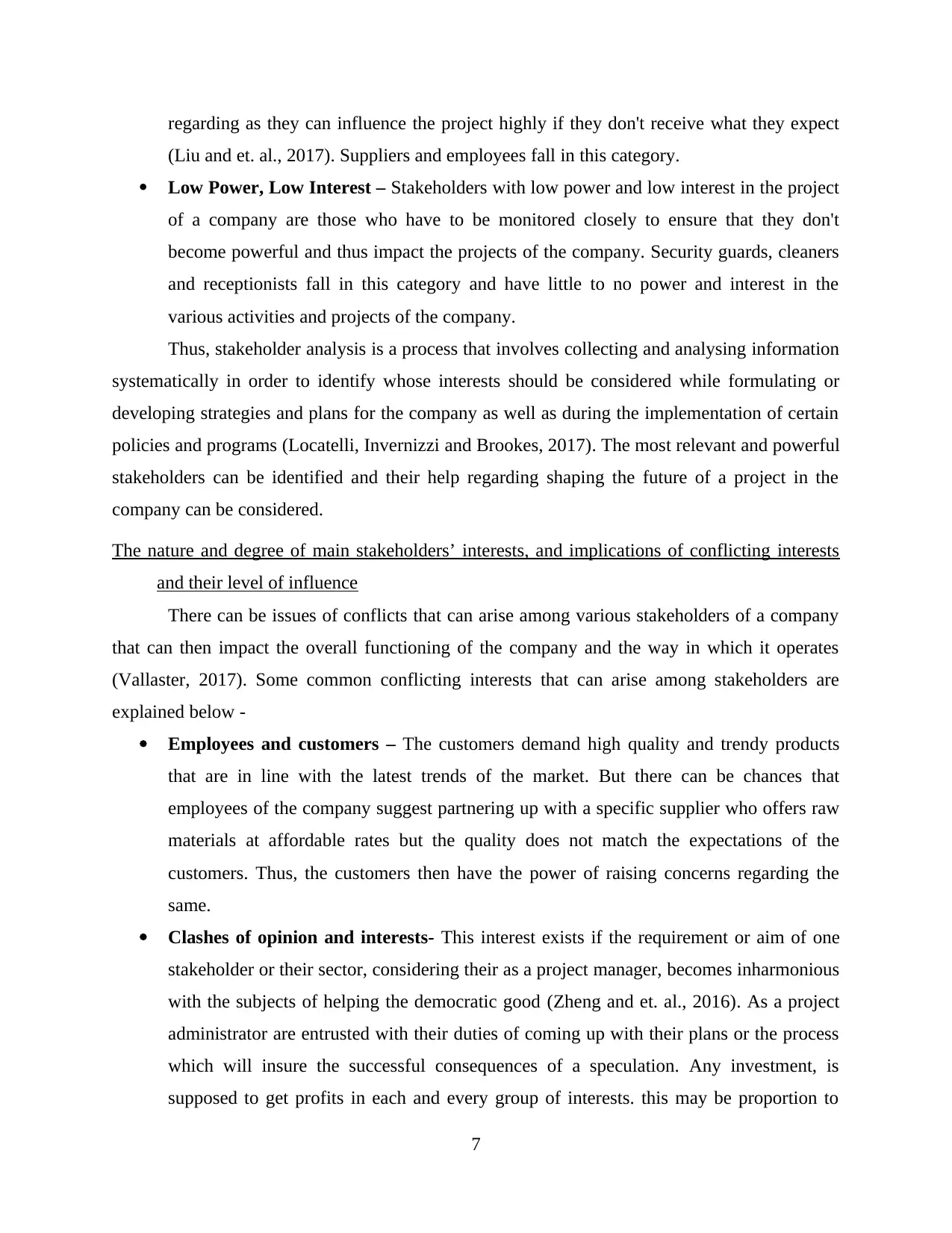
regarding as they can influence the project highly if they don't receive what they expect
(Liu and et. al., 2017). Suppliers and employees fall in this category.
Low Power, Low Interest – Stakeholders with low power and low interest in the project
of a company are those who have to be monitored closely to ensure that they don't
become powerful and thus impact the projects of the company. Security guards, cleaners
and receptionists fall in this category and have little to no power and interest in the
various activities and projects of the company.
Thus, stakeholder analysis is a process that involves collecting and analysing information
systematically in order to identify whose interests should be considered while formulating or
developing strategies and plans for the company as well as during the implementation of certain
policies and programs (Locatelli, Invernizzi and Brookes, 2017). The most relevant and powerful
stakeholders can be identified and their help regarding shaping the future of a project in the
company can be considered.
The nature and degree of main stakeholders’ interests, and implications of conflicting interests
and their level of influence
There can be issues of conflicts that can arise among various stakeholders of a company
that can then impact the overall functioning of the company and the way in which it operates
(Vallaster, 2017). Some common conflicting interests that can arise among stakeholders are
explained below -
Employees and customers – The customers demand high quality and trendy products
that are in line with the latest trends of the market. But there can be chances that
employees of the company suggest partnering up with a specific supplier who offers raw
materials at affordable rates but the quality does not match the expectations of the
customers. Thus, the customers then have the power of raising concerns regarding the
same.
Clashes of opinion and interests- This interest exists if the requirement or aim of one
stakeholder or their sector, considering their as a project manager, becomes inharmonious
with the subjects of helping the democratic good (Zheng and et. al., 2016). As a project
administrator are entrusted with their duties of coming up with their plans or the process
which will insure the successful consequences of a speculation. Any investment, is
supposed to get profits in each and every group of interests. this may be proportion to
7
(Liu and et. al., 2017). Suppliers and employees fall in this category.
Low Power, Low Interest – Stakeholders with low power and low interest in the project
of a company are those who have to be monitored closely to ensure that they don't
become powerful and thus impact the projects of the company. Security guards, cleaners
and receptionists fall in this category and have little to no power and interest in the
various activities and projects of the company.
Thus, stakeholder analysis is a process that involves collecting and analysing information
systematically in order to identify whose interests should be considered while formulating or
developing strategies and plans for the company as well as during the implementation of certain
policies and programs (Locatelli, Invernizzi and Brookes, 2017). The most relevant and powerful
stakeholders can be identified and their help regarding shaping the future of a project in the
company can be considered.
The nature and degree of main stakeholders’ interests, and implications of conflicting interests
and their level of influence
There can be issues of conflicts that can arise among various stakeholders of a company
that can then impact the overall functioning of the company and the way in which it operates
(Vallaster, 2017). Some common conflicting interests that can arise among stakeholders are
explained below -
Employees and customers – The customers demand high quality and trendy products
that are in line with the latest trends of the market. But there can be chances that
employees of the company suggest partnering up with a specific supplier who offers raw
materials at affordable rates but the quality does not match the expectations of the
customers. Thus, the customers then have the power of raising concerns regarding the
same.
Clashes of opinion and interests- This interest exists if the requirement or aim of one
stakeholder or their sector, considering their as a project manager, becomes inharmonious
with the subjects of helping the democratic good (Zheng and et. al., 2016). As a project
administrator are entrusted with their duties of coming up with their plans or the process
which will insure the successful consequences of a speculation. Any investment, is
supposed to get profits in each and every group of interests. this may be proportion to
7
Paraphrase This Document
Need a fresh take? Get an instant paraphrase of this document with our AI Paraphraser
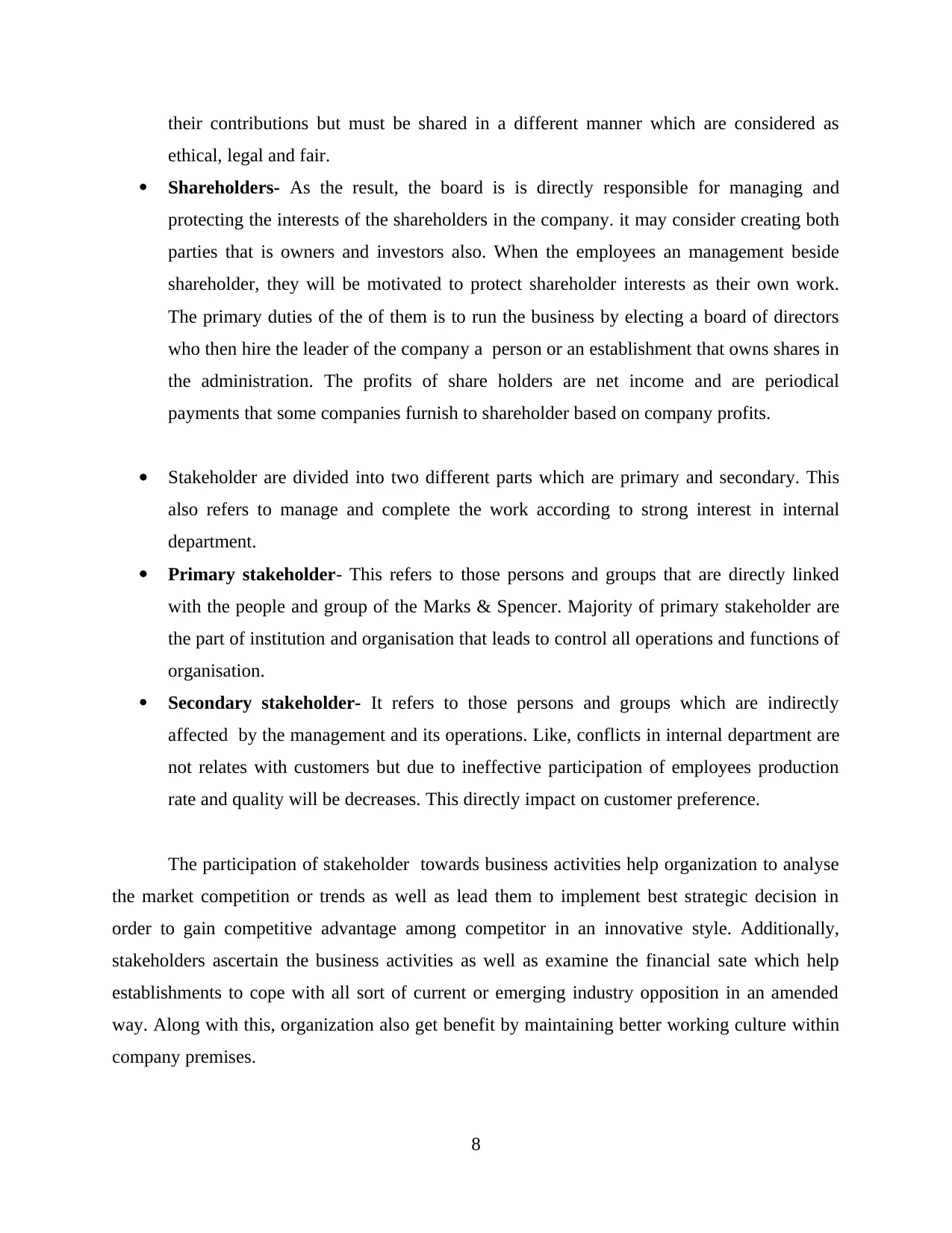
their contributions but must be shared in a different manner which are considered as
ethical, legal and fair.
Shareholders- As the result, the board is is directly responsible for managing and
protecting the interests of the shareholders in the company. it may consider creating both
parties that is owners and investors also. When the employees an management beside
shareholder, they will be motivated to protect shareholder interests as their own work.
The primary duties of the of them is to run the business by electing a board of directors
who then hire the leader of the company a person or an establishment that owns shares in
the administration. The profits of share holders are net income and are periodical
payments that some companies furnish to shareholder based on company profits.
Stakeholder are divided into two different parts which are primary and secondary. This
also refers to manage and complete the work according to strong interest in internal
department.
Primary stakeholder- This refers to those persons and groups that are directly linked
with the people and group of the Marks & Spencer. Majority of primary stakeholder are
the part of institution and organisation that leads to control all operations and functions of
organisation.
Secondary stakeholder- It refers to those persons and groups which are indirectly
affected by the management and its operations. Like, conflicts in internal department are
not relates with customers but due to ineffective participation of employees production
rate and quality will be decreases. This directly impact on customer preference.
The participation of stakeholder towards business activities help organization to analyse
the market competition or trends as well as lead them to implement best strategic decision in
order to gain competitive advantage among competitor in an innovative style. Additionally,
stakeholders ascertain the business activities as well as examine the financial sate which help
establishments to cope with all sort of current or emerging industry opposition in an amended
way. Along with this, organization also get benefit by maintaining better working culture within
company premises.
8
ethical, legal and fair.
Shareholders- As the result, the board is is directly responsible for managing and
protecting the interests of the shareholders in the company. it may consider creating both
parties that is owners and investors also. When the employees an management beside
shareholder, they will be motivated to protect shareholder interests as their own work.
The primary duties of the of them is to run the business by electing a board of directors
who then hire the leader of the company a person or an establishment that owns shares in
the administration. The profits of share holders are net income and are periodical
payments that some companies furnish to shareholder based on company profits.
Stakeholder are divided into two different parts which are primary and secondary. This
also refers to manage and complete the work according to strong interest in internal
department.
Primary stakeholder- This refers to those persons and groups that are directly linked
with the people and group of the Marks & Spencer. Majority of primary stakeholder are
the part of institution and organisation that leads to control all operations and functions of
organisation.
Secondary stakeholder- It refers to those persons and groups which are indirectly
affected by the management and its operations. Like, conflicts in internal department are
not relates with customers but due to ineffective participation of employees production
rate and quality will be decreases. This directly impact on customer preference.
The participation of stakeholder towards business activities help organization to analyse
the market competition or trends as well as lead them to implement best strategic decision in
order to gain competitive advantage among competitor in an innovative style. Additionally,
stakeholders ascertain the business activities as well as examine the financial sate which help
establishments to cope with all sort of current or emerging industry opposition in an amended
way. Along with this, organization also get benefit by maintaining better working culture within
company premises.
8
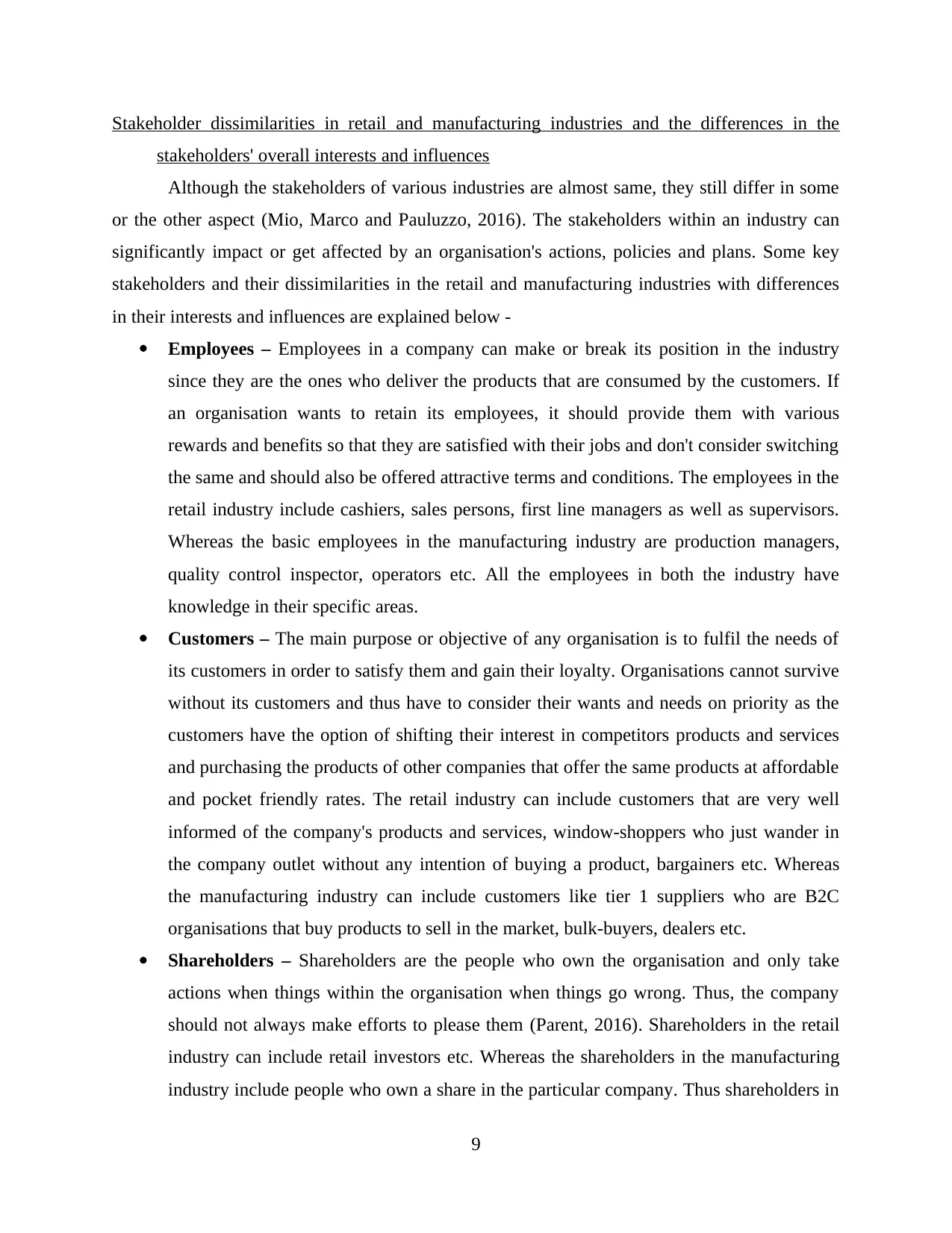
Stakeholder dissimilarities in retail and manufacturing industries and the differences in the
stakeholders' overall interests and influences
Although the stakeholders of various industries are almost same, they still differ in some
or the other aspect (Mio, Marco and Pauluzzo, 2016). The stakeholders within an industry can
significantly impact or get affected by an organisation's actions, policies and plans. Some key
stakeholders and their dissimilarities in the retail and manufacturing industries with differences
in their interests and influences are explained below -
Employees – Employees in a company can make or break its position in the industry
since they are the ones who deliver the products that are consumed by the customers. If
an organisation wants to retain its employees, it should provide them with various
rewards and benefits so that they are satisfied with their jobs and don't consider switching
the same and should also be offered attractive terms and conditions. The employees in the
retail industry include cashiers, sales persons, first line managers as well as supervisors.
Whereas the basic employees in the manufacturing industry are production managers,
quality control inspector, operators etc. All the employees in both the industry have
knowledge in their specific areas.
Customers – The main purpose or objective of any organisation is to fulfil the needs of
its customers in order to satisfy them and gain their loyalty. Organisations cannot survive
without its customers and thus have to consider their wants and needs on priority as the
customers have the option of shifting their interest in competitors products and services
and purchasing the products of other companies that offer the same products at affordable
and pocket friendly rates. The retail industry can include customers that are very well
informed of the company's products and services, window-shoppers who just wander in
the company outlet without any intention of buying a product, bargainers etc. Whereas
the manufacturing industry can include customers like tier 1 suppliers who are B2C
organisations that buy products to sell in the market, bulk-buyers, dealers etc.
Shareholders – Shareholders are the people who own the organisation and only take
actions when things within the organisation when things go wrong. Thus, the company
should not always make efforts to please them (Parent, 2016). Shareholders in the retail
industry can include retail investors etc. Whereas the shareholders in the manufacturing
industry include people who own a share in the particular company. Thus shareholders in
9
stakeholders' overall interests and influences
Although the stakeholders of various industries are almost same, they still differ in some
or the other aspect (Mio, Marco and Pauluzzo, 2016). The stakeholders within an industry can
significantly impact or get affected by an organisation's actions, policies and plans. Some key
stakeholders and their dissimilarities in the retail and manufacturing industries with differences
in their interests and influences are explained below -
Employees – Employees in a company can make or break its position in the industry
since they are the ones who deliver the products that are consumed by the customers. If
an organisation wants to retain its employees, it should provide them with various
rewards and benefits so that they are satisfied with their jobs and don't consider switching
the same and should also be offered attractive terms and conditions. The employees in the
retail industry include cashiers, sales persons, first line managers as well as supervisors.
Whereas the basic employees in the manufacturing industry are production managers,
quality control inspector, operators etc. All the employees in both the industry have
knowledge in their specific areas.
Customers – The main purpose or objective of any organisation is to fulfil the needs of
its customers in order to satisfy them and gain their loyalty. Organisations cannot survive
without its customers and thus have to consider their wants and needs on priority as the
customers have the option of shifting their interest in competitors products and services
and purchasing the products of other companies that offer the same products at affordable
and pocket friendly rates. The retail industry can include customers that are very well
informed of the company's products and services, window-shoppers who just wander in
the company outlet without any intention of buying a product, bargainers etc. Whereas
the manufacturing industry can include customers like tier 1 suppliers who are B2C
organisations that buy products to sell in the market, bulk-buyers, dealers etc.
Shareholders – Shareholders are the people who own the organisation and only take
actions when things within the organisation when things go wrong. Thus, the company
should not always make efforts to please them (Parent, 2016). Shareholders in the retail
industry can include retail investors etc. Whereas the shareholders in the manufacturing
industry include people who own a share in the particular company. Thus shareholders in
9
⊘ This is a preview!⊘
Do you want full access?
Subscribe today to unlock all pages.

Trusted by 1+ million students worldwide
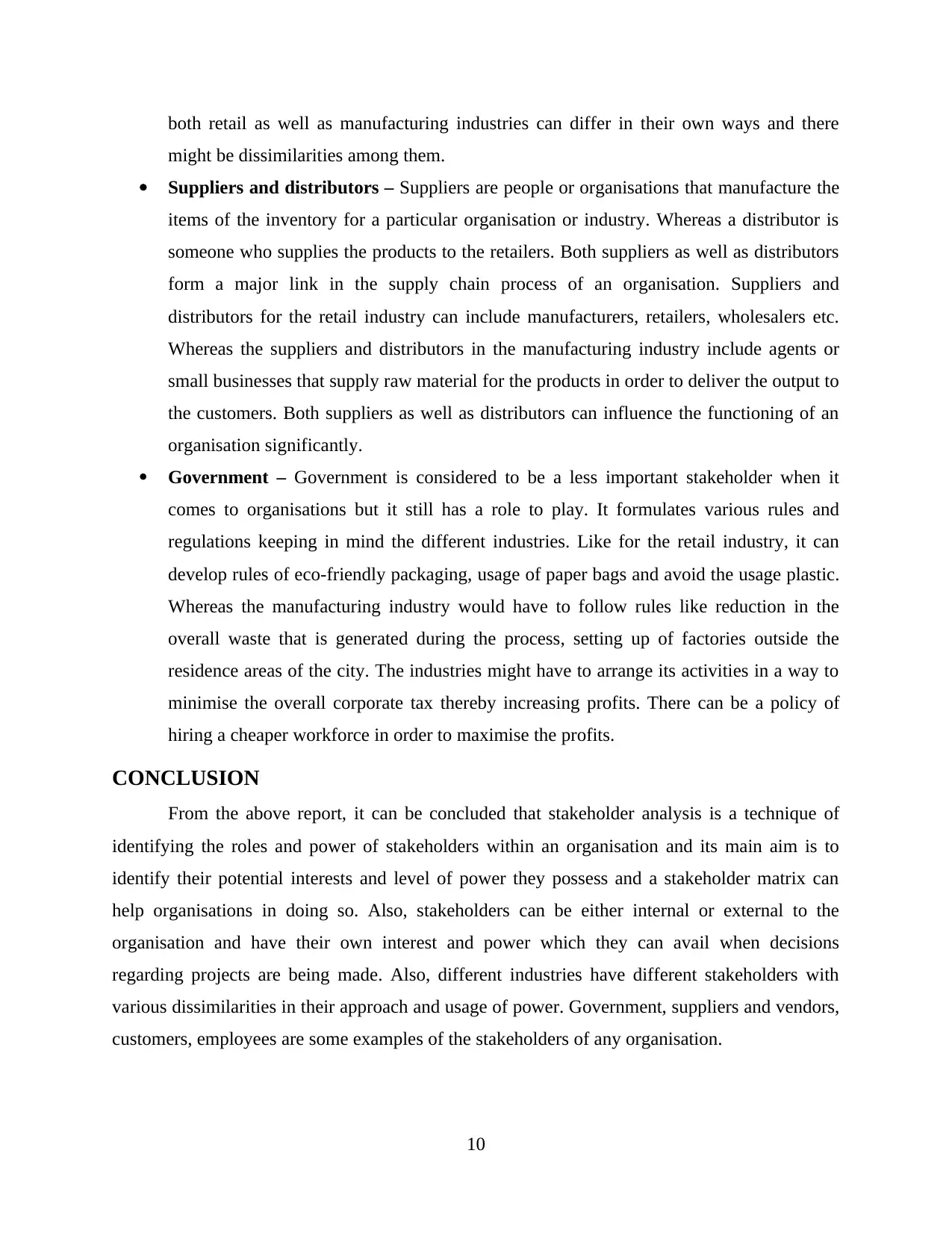
both retail as well as manufacturing industries can differ in their own ways and there
might be dissimilarities among them.
Suppliers and distributors – Suppliers are people or organisations that manufacture the
items of the inventory for a particular organisation or industry. Whereas a distributor is
someone who supplies the products to the retailers. Both suppliers as well as distributors
form a major link in the supply chain process of an organisation. Suppliers and
distributors for the retail industry can include manufacturers, retailers, wholesalers etc.
Whereas the suppliers and distributors in the manufacturing industry include agents or
small businesses that supply raw material for the products in order to deliver the output to
the customers. Both suppliers as well as distributors can influence the functioning of an
organisation significantly.
Government – Government is considered to be a less important stakeholder when it
comes to organisations but it still has a role to play. It formulates various rules and
regulations keeping in mind the different industries. Like for the retail industry, it can
develop rules of eco-friendly packaging, usage of paper bags and avoid the usage plastic.
Whereas the manufacturing industry would have to follow rules like reduction in the
overall waste that is generated during the process, setting up of factories outside the
residence areas of the city. The industries might have to arrange its activities in a way to
minimise the overall corporate tax thereby increasing profits. There can be a policy of
hiring a cheaper workforce in order to maximise the profits.
CONCLUSION
From the above report, it can be concluded that stakeholder analysis is a technique of
identifying the roles and power of stakeholders within an organisation and its main aim is to
identify their potential interests and level of power they possess and a stakeholder matrix can
help organisations in doing so. Also, stakeholders can be either internal or external to the
organisation and have their own interest and power which they can avail when decisions
regarding projects are being made. Also, different industries have different stakeholders with
various dissimilarities in their approach and usage of power. Government, suppliers and vendors,
customers, employees are some examples of the stakeholders of any organisation.
10
might be dissimilarities among them.
Suppliers and distributors – Suppliers are people or organisations that manufacture the
items of the inventory for a particular organisation or industry. Whereas a distributor is
someone who supplies the products to the retailers. Both suppliers as well as distributors
form a major link in the supply chain process of an organisation. Suppliers and
distributors for the retail industry can include manufacturers, retailers, wholesalers etc.
Whereas the suppliers and distributors in the manufacturing industry include agents or
small businesses that supply raw material for the products in order to deliver the output to
the customers. Both suppliers as well as distributors can influence the functioning of an
organisation significantly.
Government – Government is considered to be a less important stakeholder when it
comes to organisations but it still has a role to play. It formulates various rules and
regulations keeping in mind the different industries. Like for the retail industry, it can
develop rules of eco-friendly packaging, usage of paper bags and avoid the usage plastic.
Whereas the manufacturing industry would have to follow rules like reduction in the
overall waste that is generated during the process, setting up of factories outside the
residence areas of the city. The industries might have to arrange its activities in a way to
minimise the overall corporate tax thereby increasing profits. There can be a policy of
hiring a cheaper workforce in order to maximise the profits.
CONCLUSION
From the above report, it can be concluded that stakeholder analysis is a technique of
identifying the roles and power of stakeholders within an organisation and its main aim is to
identify their potential interests and level of power they possess and a stakeholder matrix can
help organisations in doing so. Also, stakeholders can be either internal or external to the
organisation and have their own interest and power which they can avail when decisions
regarding projects are being made. Also, different industries have different stakeholders with
various dissimilarities in their approach and usage of power. Government, suppliers and vendors,
customers, employees are some examples of the stakeholders of any organisation.
10
Paraphrase This Document
Need a fresh take? Get an instant paraphrase of this document with our AI Paraphraser
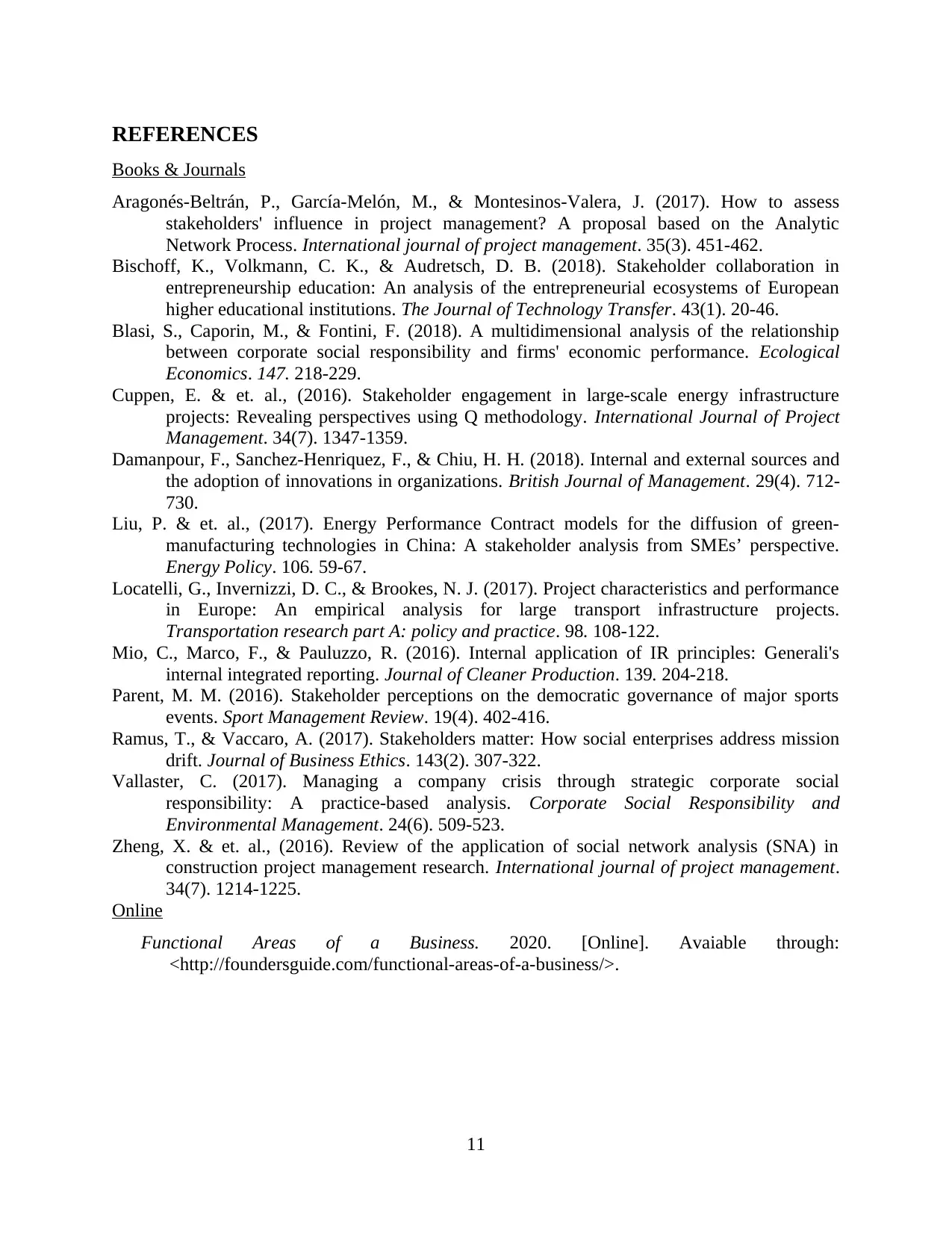
REFERENCES
Books & Journals
Aragonés-Beltrán, P., García-Melón, M., & Montesinos-Valera, J. (2017). How to assess
stakeholders' influence in project management? A proposal based on the Analytic
Network Process. International journal of project management. 35(3). 451-462.
Bischoff, K., Volkmann, C. K., & Audretsch, D. B. (2018). Stakeholder collaboration in
entrepreneurship education: An analysis of the entrepreneurial ecosystems of European
higher educational institutions. The Journal of Technology Transfer. 43(1). 20-46.
Blasi, S., Caporin, M., & Fontini, F. (2018). A multidimensional analysis of the relationship
between corporate social responsibility and firms' economic performance. Ecological
Economics. 147. 218-229.
Cuppen, E. & et. al., (2016). Stakeholder engagement in large-scale energy infrastructure
projects: Revealing perspectives using Q methodology. International Journal of Project
Management. 34(7). 1347-1359.
Damanpour, F., Sanchez‐Henriquez, F., & Chiu, H. H. (2018). Internal and external sources and
the adoption of innovations in organizations. British Journal of Management. 29(4). 712-
730.
Liu, P. & et. al., (2017). Energy Performance Contract models for the diffusion of green-
manufacturing technologies in China: A stakeholder analysis from SMEs’ perspective.
Energy Policy. 106. 59-67.
Locatelli, G., Invernizzi, D. C., & Brookes, N. J. (2017). Project characteristics and performance
in Europe: An empirical analysis for large transport infrastructure projects.
Transportation research part A: policy and practice. 98. 108-122.
Mio, C., Marco, F., & Pauluzzo, R. (2016). Internal application of IR principles: Generali's
internal integrated reporting. Journal of Cleaner Production. 139. 204-218.
Parent, M. M. (2016). Stakeholder perceptions on the democratic governance of major sports
events. Sport Management Review. 19(4). 402-416.
Ramus, T., & Vaccaro, A. (2017). Stakeholders matter: How social enterprises address mission
drift. Journal of Business Ethics. 143(2). 307-322.
Vallaster, C. (2017). Managing a company crisis through strategic corporate social
responsibility: A practice‐based analysis. Corporate Social Responsibility and
Environmental Management. 24(6). 509-523.
Zheng, X. & et. al., (2016). Review of the application of social network analysis (SNA) in
construction project management research. International journal of project management.
34(7). 1214-1225.
Online
Functional Areas of a Business. 2020. [Online]. Avaiable through:
<http://foundersguide.com/functional-areas-of-a-business/>.
11
Books & Journals
Aragonés-Beltrán, P., García-Melón, M., & Montesinos-Valera, J. (2017). How to assess
stakeholders' influence in project management? A proposal based on the Analytic
Network Process. International journal of project management. 35(3). 451-462.
Bischoff, K., Volkmann, C. K., & Audretsch, D. B. (2018). Stakeholder collaboration in
entrepreneurship education: An analysis of the entrepreneurial ecosystems of European
higher educational institutions. The Journal of Technology Transfer. 43(1). 20-46.
Blasi, S., Caporin, M., & Fontini, F. (2018). A multidimensional analysis of the relationship
between corporate social responsibility and firms' economic performance. Ecological
Economics. 147. 218-229.
Cuppen, E. & et. al., (2016). Stakeholder engagement in large-scale energy infrastructure
projects: Revealing perspectives using Q methodology. International Journal of Project
Management. 34(7). 1347-1359.
Damanpour, F., Sanchez‐Henriquez, F., & Chiu, H. H. (2018). Internal and external sources and
the adoption of innovations in organizations. British Journal of Management. 29(4). 712-
730.
Liu, P. & et. al., (2017). Energy Performance Contract models for the diffusion of green-
manufacturing technologies in China: A stakeholder analysis from SMEs’ perspective.
Energy Policy. 106. 59-67.
Locatelli, G., Invernizzi, D. C., & Brookes, N. J. (2017). Project characteristics and performance
in Europe: An empirical analysis for large transport infrastructure projects.
Transportation research part A: policy and practice. 98. 108-122.
Mio, C., Marco, F., & Pauluzzo, R. (2016). Internal application of IR principles: Generali's
internal integrated reporting. Journal of Cleaner Production. 139. 204-218.
Parent, M. M. (2016). Stakeholder perceptions on the democratic governance of major sports
events. Sport Management Review. 19(4). 402-416.
Ramus, T., & Vaccaro, A. (2017). Stakeholders matter: How social enterprises address mission
drift. Journal of Business Ethics. 143(2). 307-322.
Vallaster, C. (2017). Managing a company crisis through strategic corporate social
responsibility: A practice‐based analysis. Corporate Social Responsibility and
Environmental Management. 24(6). 509-523.
Zheng, X. & et. al., (2016). Review of the application of social network analysis (SNA) in
construction project management research. International journal of project management.
34(7). 1214-1225.
Online
Functional Areas of a Business. 2020. [Online]. Avaiable through:
<http://foundersguide.com/functional-areas-of-a-business/>.
11

12
⊘ This is a preview!⊘
Do you want full access?
Subscribe today to unlock all pages.

Trusted by 1+ million students worldwide
1 out of 12
Related Documents
Your All-in-One AI-Powered Toolkit for Academic Success.
+13062052269
info@desklib.com
Available 24*7 on WhatsApp / Email
![[object Object]](/_next/static/media/star-bottom.7253800d.svg)
Unlock your academic potential
Copyright © 2020–2025 A2Z Services. All Rights Reserved. Developed and managed by ZUCOL.





